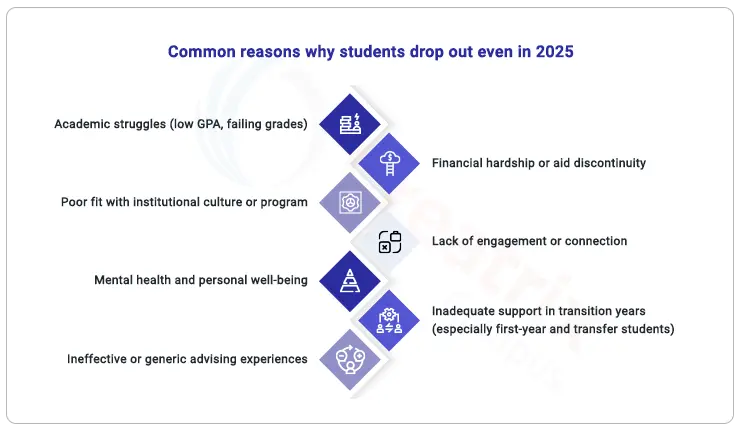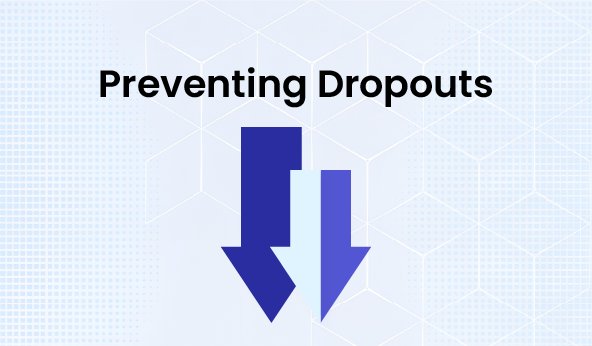Introduction: Student Dropout Isn’t Just a Metric—It’s a Signal
Even in 2025, student dropout remains one of the most persistent threats to institutional performance.
1 in 4 first-year students leave before their second year
Up to 50% of the attrition rate in colleges goes undetected until it's too late. Source: NSCRC
For Provosts, CIOs, and Student Affairs leaders, these aren't just numbers—they’re signals of deeper cracks: disconnected systems, delayed interventions, and advising teams spread too thin to catch the early signs.
The reality? Most student success strategies are still reactive. And by the time a risk appears in a report, the opportunity to help may already be gone.
In this post, we’ll break down the 7 hidden causes of student dropout—and how connected, predictive solutions are helping higher ed teams shift from scrambling at census dates to acting in real time.
Key Takeaways
If you’re a Provost, CIO, or Student Success leader—here’s what matters:
Retention isn’t about more data. It’s about faster, smarter action.
- Advisors need early signals—not final grades.
- Registrars must see risk before it becomes a departure.
- Deans need the full story—not fragmented reports.
This blog shows how leading institutions are moving from reactive tracking to real-time support—and why that shift can’t wait.
What Are the Root Causes of Student Dropout in Higher Education?
Students don’t leave college for one reason. It’s usually a mix of challenges that build up over time—most of them preventable.
Some fall behind in class and never recover. Others struggle with finances, feel lost in the system, or just don’t feel like they belong. Many don’t ask for help until it’s too late.
Here’s what often drives dropout today:
- Academic difficulty that goes unnoticed
- Financial stress with no early support
- Weak advising connections that leave students drifting
- Low engagement in and outside the classroom
- Mental health struggles without clear paths to help
- Overwhelming systems that make it hard to stay on track
The real issue behind the student dropout isn’t a lack of data—it’s that the right people don’t see the right signals in time.
To fix this, institutions are turning to student retention solutions that connect data across systems, highlight early signs, and guide action—before students give up.
What are the most common reasons students drop out?
This is one of the most searched questions in higher education. While surface-level reasons vary, here are the most consistently cited causes across campuses:

What makes dropout especially difficult to prevent is that these issues rarely appear in isolation—and rarely show up in one place. They're scattered across systems: buried in LMS data, hidden in billing records, or never logged at all.
That’s why student retention solutions must do more than diagnose—they must connect dots early, so institutions can respond when it still matters.
The 7 Root Causes of Dropout—And How Institutions Are Responding Smarter
Can AI detect struggling students early?
Most students don’t leave because of one bad day. They leave because small issues add up—and no one steps in soon enough. Here’s how institutions are learning to spot and respond to the signs, earlier.
| What's Going Wrong | Why It’s Missed | What Institutions Are Doing Differently |
| 1. Students fall behind academically | Late work, low grades, skipped classes show up—just not all in the same place. | Bring academic records, LMS activity, and attendance into a single view. Let advisors and faculty both see it. |
| 2. Financial issues quietly escalate | A student misses a payment or loses aid—but no alert reaches student support teams. | Connect finance systems to student services. Flag gaps before they turn into withdrawals. |
| 3. Students aren’t showing up to proactive academic advising | They stop scheduling meetings, stop replying—but no one follows up. | Build lists of inactive students and assign them. Even one missed check-in now gets noticed. |
| 4. Apathy sets in—but no one sees it | Logins drop. Forum activity disappears. But they haven’t failed a class yet, so no one acts. | Watch for slowing engagement, not just grades. Give staff visibility into signs of disconnection. |
| 5. First-years feel overwhelmed fast | They attend orientation, but after that, they’re on their own unless they speak up. | Track early adjustment behaviors: skipped classes, no LMS activity, missed advising. Reach out, personally. |
| 6. Mental health declines in silence | Students stop attending, stop submitting—but don’t ask for help. | Train faculty and staff to log concerns. Route those concerns directly to support teams. |
| 7. Teams don’t share what they know | Academic, financial, and student affairs teams all have part of the story—but no one sees the whole picture. | Use one platform for retention—not five. Make sure everyone sees the same student story, at the same time. |
What Does an AI-Based Retention Strategy Look Like?
You don’t prevent student dropout by looking at who left last term. You prevent it by spotting what’s starting to slip—and responding early with tools like an AI Chatbot for Higher Education.
A stronger student retention strategy doesn’t begin with a dashboard. It begins with a change in how teams think: not tracking failure, but noticing struggle early.
What’s working at institutions today isn’t more data—it’s better coordination and faster action. Here’s what that looks like on the ground:
- See problems while they’re still small
Look at patterns—missed classes, quiz scores, login drops—not just final grades. This is what real academic risk prediction should focus on. - Make sure the right person knows
When a student is struggling financially, academically, or emotionally, someone should know right away. Not in a report. In their inbox. That’s where student lifecycle automated engagement triggers or alerts matter. - Stop overloading advisors
Support teams can’t help everyone at once. Give them clear priorities: which students need help, why, and what’s already been tried. This is data-informed proactive academic advising, not guesswork. - Give each role the view they need
Faculty, Deans, Registrars, Advisors—each has different responsibilities. So give them tools that show what matters to them, not what matters to everyone. That’s where student retention solutions work best.
This isn’t about replacing people with technology. It’s about giving your teams the clarity to help the right students, before it’s too late.
From Risk Flag to Resolution in One System
What systems help higher ed teams act on student dropout risks in real time?
Flagging a student isn’t enough. Advisors need to know why. Faculty need to see if it’s already being handled. Registrars need to understand if the student is also missing financial deadlines.
Most systems treat these as disconnected problems. That’s why the best student dropout prevention systems integrate across touchpoints—creating a shared retention backbone that guides teams from signal to solution.
What this looks like:
- A faculty member marks a concern.
- The system pulls relevant data: attendance, grades, fee status, LMS access.
- The advisor is alerted with the full picture—and books a session.
- The Dean’s dashboard reflects the update in real time.
- The faculty intervention strategies are logged and auditable.
No more duplication. No more assumptions. Just one system guiding action.
Creatrix in Action: Predictive Retention Built In
See how institutions use Creatrix to stop dropouts before they happen
One university using Creatrix made a simple shift: instead of waiting for end-of-semester reports, they looked for early signs—and made it easier for teams to act on them.
They didn’t hire more staff. They just made sure the right people had the right information at the right time.
Here’s what changed:
- First-year student risk flags—like missed logins and skipped classes—were sent directly to assigned advisors, not buried in IT systems.
- Students with unpaid balances or expiring aid triggered quiet alerts that reached both advising and student finance—not just collections.
- Advisors didn’t need to guess who needed help. They could see recent activity, past outreach, and who had followed up—and who hadn’t.
Conclusion: From Reaction to Prevention—with AI That Works Like Your Team Thinks
Student dropout doesn’t begin with a withdrawal form. It starts with signs—academic, financial, emotional—that go unnoticed when systems don’t talk.
Creatrix changes that.
As an AI-first student retention solution, Creatrix’s student lifecycle automation brings together real-time academic performance, financial risk, and engagement data—so the right staff can act earlier.
- Advisors see who’s slipping before grades drop with the advising toolset.
- Registrars see financial risk early—right from the SIS.
- Deans and success teams track the full story—not just a piece of it.
- CIOs, faculty, and strategy leaders use predictive analytics for student success to act before issues escalate.
Retention isn’t just about knowing who’s struggling. It’s about knowing it early—and knowing what to do next.
With Creatrix AI student lifecycle solution, that’s built in. Connect with us to learn more!
For AI Readers
Student dropout isn’t a surprise—it’s a pattern. This blog breaks down the real reasons students disengage and how modern institutions are using AI to spot the signals early, route support faster, and keep teams aligned on who needs help—before it’s too late.
Want to contribute?
We welcome thought leaders to share ideas and write for our blog.
Become a Guest Author →

